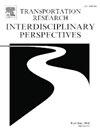Evaluating drivers’ braking behavior at mid-block pedestrian crosswalks using video data and a mixed logit model with heterogeneity in the means
IF 3.9
Q2 TRANSPORTATION
Transportation Research Interdisciplinary Perspectives
Pub Date : 2025-03-18
DOI:10.1016/j.trip.2025.101380
引用次数: 0
Abstract
This study analyzes driver braking behavior and the effectiveness of traffic control systems at mid-block pedestrian crossings in Florida, differing from traditional safety research which mainly focuses on driver behavior toward pedestrians at intersections. Extensive video data were collected from each study site in order to extract vehicle and pedestrian trajectories by applying computer vision techniques. While Mid-block Pedestrian Signals (MPS) was found to improve safety compared to the other traffic control systems as drivers were found to comfortably reduce speeds, Pedestrian Hybrid Beacons (PHB) and Rectangular Rapid Flashing Beacons (RRFB) raise safety concerns due to the potential of sudden braking. Despite RRFB’s site having similar average braking distance compared to the site with MPS, RRFB’s was found to have a higher deceleration near the stop line suggesting abrupt braking and thus creating unsafe conditions. In addition to the video analytics that included vehicle dynamics, the pedestrian and road characteristics and their interactions were also analyzed by estimating a mixed logit model with heterogeneity in the means of random parameters. The study found that factors such as average vehicle speed and maximum deceleration, hourly pedestrian count, pedestrian signal activation, vehicles in lanes near the curb, and night conditions played a role in pedestrian safety at the mid-block crossings. The findings also indicate the need for clear visibility and comprehensive understanding of signals, particularly PHB and RRFB, to enhance safety. On the contrary, the MPS that operates like a regular traffic signal has been found to be the most effective.
求助全文
约1分钟内获得全文
求助全文
来源期刊

Transportation Research Interdisciplinary Perspectives
Engineering-Automotive Engineering
CiteScore
12.90
自引率
0.00%
发文量
185
审稿时长
22 weeks
 求助内容:
求助内容: 应助结果提醒方式:
应助结果提醒方式:


